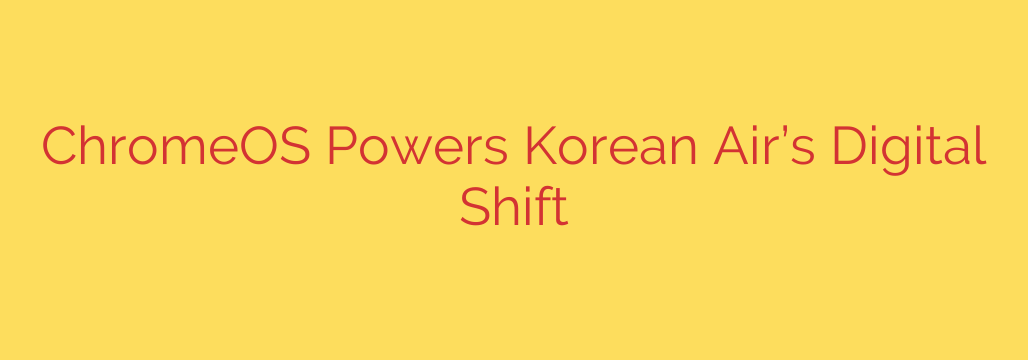
Fueling the Future: How ChromeOS is Driving Enterprise Digital Transformation
In today’s fast-paced business world, legacy technology can be a significant drag on productivity and security. Sluggish boot times, constant manual updates, and complex security patching can leave employees frustrated and IT teams overwhelmed. This challenge prompted one of the world’s largest airlines to undertake a massive digital overhaul, demonstrating how a strategic shift to a cloud-native operating system can revolutionize enterprise operations.
By moving thousands of its employees to ChromeOS, the company addressed critical vulnerabilities and unlocked new levels of efficiency, providing a powerful blueprint for other organizations looking to modernize their infrastructure.
The Challenge: Overcoming Outdated Systems
Before the transition, the airline’s workforce contended with slow devices that hampered productivity from the moment they were switched on. The reliance on older systems created significant security concerns and made it difficult to adapt to the growing demand for flexible, remote work.
The need for a change became undeniable as the company sought a solution that was fast, secure, and easy to manage for a distributed workforce. The goal was to empower employees with tools that worked seamlessly, allowing them to focus on their tasks rather than wrestling with technology.
The Cloud-Native Solution: A Seamless Shift to ChromeOS
The company embarked on a strategic migration, ultimately deploying over 6,000 Chromebooks to its staff. The transition began with a successful pilot program for 100 employees, whose positive feedback confirmed the benefits of the new platform. The full deployment was remarkably swift, completed in just two months.
This rapid adoption was made possible by the simplicity of ChromeOS and its seamless integration with Google Workspace, which the company was already using. The new cloud-first environment provided a unified, intuitive experience for employees, whether they were working from the head office, a remote location, or at home.
Key Benefits of an Enterprise ChromeOS Adoption
The move yielded immediate and measurable improvements across the organization, centered on three core areas: security, productivity, and manageability.
1. Enhanced Security by Default
For any large enterprise, security is paramount. ChromeOS provides a fundamentally secure environment with features like sandboxing, verified boot, and automatic background updates. This multi-layered defense mechanism protects against malware and other cyber threats without requiring constant user or IT intervention.
The results speak for themselves: since making the switch, the airline has reported zero security incidents on its new devices. This highlights the power of a modern OS designed with security at its core, drastically reducing risk and freeing up IT resources to focus on other strategic initiatives.
2. A Major Boost in Employee Productivity
Perhaps the most immediate benefit felt by employees was speed. Chromebooks boot up in under 10 seconds, eliminating the frustrating delays common with older systems. This allows staff to get to work instantly and access cloud-based applications without interruption.
This newfound speed and efficiency led to overwhelmingly positive employee feedback. By providing a reliable and fast user experience, the company eliminated a major source of daily frustration and empowered its workforce to be more effective. The airline is even developing a new in-flight service app designed to run on the ChromeOS platform, further extending these benefits to its frontline operations.
3. Simplified Management and Lower Total Cost of Ownership
Managing a large fleet of devices is a complex task. ChromeOS simplifies this process through the centralized Google Admin console. The airline’s IT team can now deploy, monitor, and secure all 6,000 devices from a single dashboard, whether they are on-site or remote. This has dramatically reduced the time and effort required for device management.
Furthermore, the shift has led to a lower total cost of ownership (TCO). With reduced needs for complex security software, lengthy support calls, and manual maintenance, the company has optimized its IT spending while delivering a superior technology experience to its employees.
Actionable Security Tips for Your Business
This successful transition offers valuable lessons for any organization. If you are considering a similar move or simply want to improve your company’s security posture, here are a few actionable tips:
- Prioritize Cloud-Native Solutions: Adopt operating systems and applications built for the cloud to enhance security and support flexible work arrangements.
- Automate Security Updates: Choose platforms that handle security patches automatically. This ensures all devices are protected against the latest threats without relying on manual intervention.
- Run a Pilot Program: Before a full-scale rollout, test new technology with a smaller group of users. This helps identify potential challenges and builds momentum for wider adoption.
- Centralize Device Management: Use a unified management console to streamline the deployment, security, and maintenance of all company devices, saving your IT team valuable time and resources.
By embracing a modern, secure, and cloud-first IT strategy, businesses can not only protect themselves from evolving threats but also unlock the full potential of their workforce.
Source: https://cloud.google.com/blog/products/chrome-enterprise/how-chromeos-propelled-korean-airs-digital-transformation/








